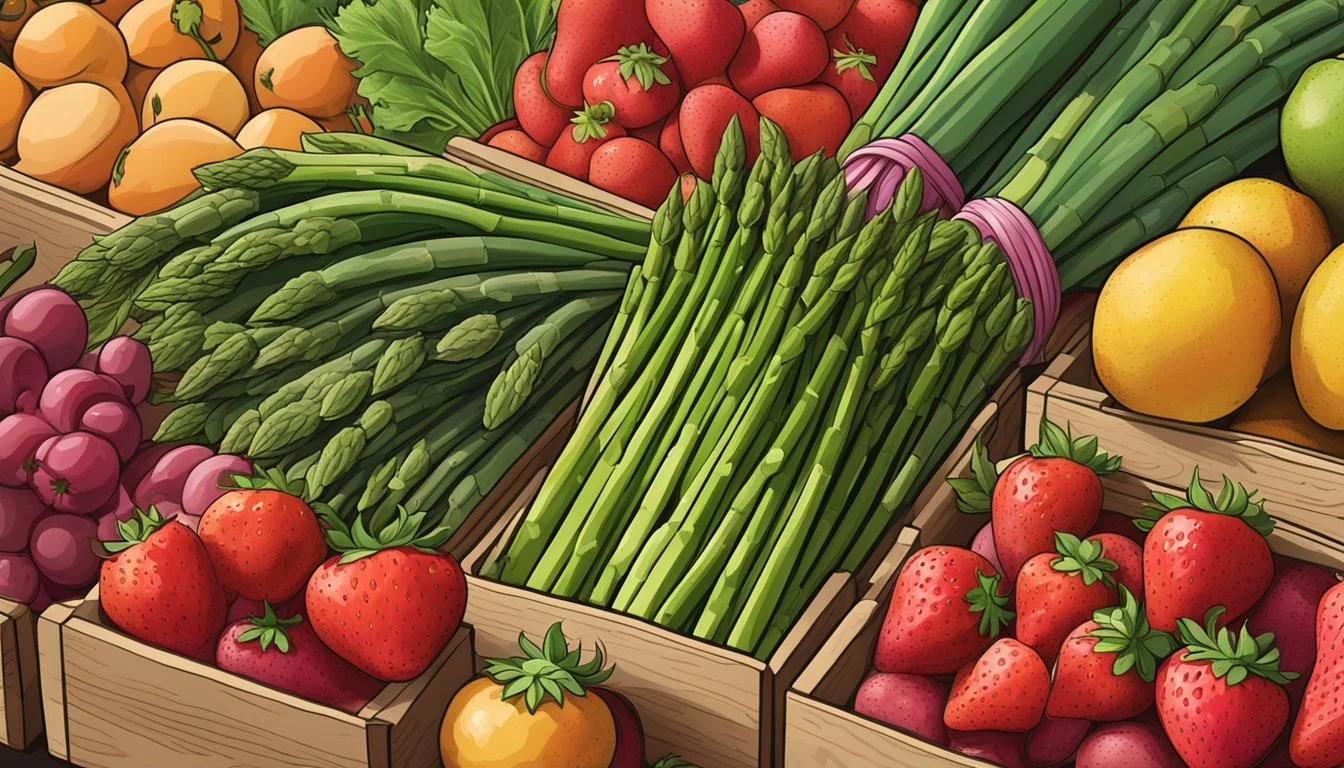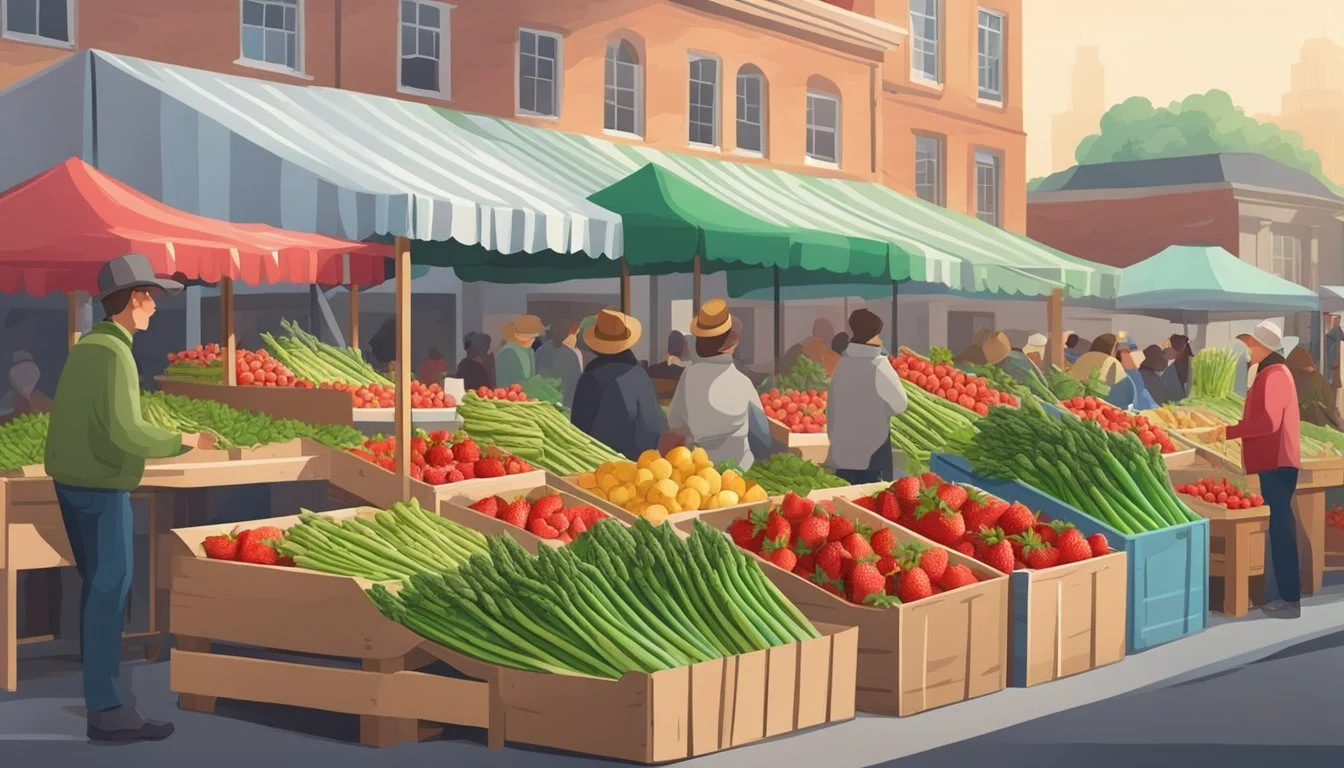North Dakota Seasonal Fruit & Vegetables in April
Your Fresh Guide
This Article is Part of our North Dakota Seasonal Fruit & Veg Calendar
In North Dakota, April is a transitional month where the last traces of winter begin to fade, giving way to the early signs of spring. This period ushers in a unique phase for agricultural produce, where specific fruits and vegetables start becoming available in alignment with the seasonal cycle. The state's vast and varied climate contributes to the growing conditions, influencing which crops are harvested and when. For residents and chefs alike, understanding the seasonal availability of produce is essential for experiencing the freshest flavors and for supporting local farmers.
Seasonal produce in April can be somewhat limited due to the lingering cold, but it is a significant time for certain crops that thrive in cooler temperatures. While fruits are scarce, vegetables such as radishes and spinach (What wine goes well with spinach?) begin to make their appearance. These hardy varieties can withstand the cooler nights and are some of the first to emerge in the growing season. Meanwhile, stored produce from the previous harvest, including root vegetables like carrots and parsnips, continue to be available, offering hearty options for springtime meals.
It’s important for consumers to be aware of the local seasonal calendar, as this helps in making informed decisions at the market. By opting for vegetables that are in season in April, individuals not only enjoy peak freshness and flavor but also contribute to the local economy and sustainable agricultural practices. The commitment to seasonal eating in North Dakota supports a thriving community of growers and producers, maintaining a vital connection between the land and its inhabitants.
Seasonal Overview
In North Dakota, April marks a transition to Spring, bringing a shift in available produce characterized by freshness and vibrant flavors. This month offers a variety of fruits and vegetables that not only enhance the taste of seasonal dishes but also provide numerous nutritional benefits.
Understanding Seasonality
Seasonality refers to the time of year when fruits and vegetables are at their peak in terms of flavor, nutritional value, and availability. April's cool to moderate temperatures are suitable for the growth of certain produce, ensuring they are fresh and of high quality. In North Dakota, understanding seasonality is crucial for selecting the best produce that is locally sourced, thus supporting the local farming community and economy.
April's Seasonal Produce
Vegetables:
Asparagus (What wine goes well with asparagus??)
Spinach
Lettuce
Fruit:
The selection of vegetables in April includes greens like spinach and lettuce, which thrive in the cooler start to spring. Asparagus begins to make an appearance, signaling the start of its season, while the tartness of rhubarb offers a unique flavor for desserts and sauces.
Nutritional Benefits
The produce that comes into season in April brings a range of nutritional benefits. Greens like spinach are high in vitamins A, C, and K, as well as minerals such as iron and magnesium. Asparagus is known for its fiber content and is a good source of folate. Rhubarb, although often used with sugar in recipes, is low in calories and provides vitamin K and calcium when consumed in its raw form. Freshness is not only a marker of flavor but also of higher nutritional quality, as freshly harvested produce retains more nutrients.
Fruits in Season
In North Dakota, April ushers in the opportunity to enjoy a limited selection of fruits that thrive in the early spring climate. Among these, rhubarb and apricots begin to make their seasonal debut.
Rhubarb
Rhubarb is one of the first plants to break ground in the spring and holds the distinction of being both a vegetable and a fruit in culinary uses. It is typically ready for harvest in April. Known for its tart flavor, rhubarb is often utilized in desserts, such as pies and jam, balancing its acidity with sweetener.
Apricots
While the apricot harvest is generally brief and subject to the whims of spring weather, North Dakota may see apricots available in later April. These stone fruits, when ripened on the tree, exhibit a sweet and fragrant flavor profile that can be savored fresh or used in various sweet and savory dishes.
Vegetables in Season
In April, North Dakota greets the spring with a selection of fresh, flavorful vegetables. Shoppers and chefs can look forward to crisp asparagus, peppery radishes, tender spinach, and sweet snow peas as the prominent local produce.
Asparagus
The beginning of April marks the arrival of asparagus season in North Dakota. Known for its vibrant green color and tender stalks, asparagus is at its peak in both flavor and nutrition. This versatile vegetable can be grilled, roasted, or steamed for a variety of dishes.
Radishes
Radishes, with their distinctive pepper-like flavor, add a crunch to any salad or dish. They are one of the first root vegetables to be harvested. Their quick growing cycle means that come April, they are fresh, crisp, and abundant in markets across the state.
Spinach
Spinach thrives in the cool temperatures of early spring. North Dakota's April spinach is known for its dark, leafy greens that are rich in iron and vitamins. This vegetable is perfect for salads, smoothies, and as a cooked side.
Snow Peas
Snow peas are tender and sweet, making them a popular choice for stir-fries, salads, and snacks. They are typically harvested in the early weeks of spring when the pods are still flat and the peas have not fully developed inside.
Local Farming Practices
In North Dakota, local farms embrace agricultural models that prioritize sustainable and organic practices, contributing to the state's robust farm-to-table movement. These practices are essential for producing high-quality fruits and vegetables that are in season come April.
Sustainable Agriculture
Farmers in North Dakota are committed to sustainable agriculture, utilizing techniques that ensure long-term soil health and environmental care. Crop rotation and conservation tillage are common in the region, as they help maintain soil structure and fertility. Research into sustainable methods is supported by local institutions, aiming for an agriculture system that can endure without depleting resources.
Organic Farming
Organic farming is a growing sector in North Dakota's agriculture scene. Producers adhere to standards that forbid the use of synthetic pesticides and fertilizers. Instead, they rely on natural substances and physical, mechanical, or biologically based farming methods. Farms obtain certification through rigorous assessments, adding to the integrity of organic produce available in the state.
Certification process: Rigorous assessments
No synthetic pesticides/fertilizers used
Farm to Table Movement
The farm-to-table movement in North Dakota emphasizes direct sales of produce from farms to consumers, restaurants, and local markets. Data shows this method boosts the local economy and ensures consumers have access to the freshest seasonal produce. The movement relies on strong relationships between local farms, businesses, and consumers, highlighting transparency in the food supply chain.
Direct sales: From farms to consumers
Fresh produce: Access to seasonal goods
Local economy: Strengthened by direct sales
Food Preservation and Storage
Proper preservation and storage are critical to maintaining the flavor and nutritional value of fruits and vegetables in North Dakota. By employing techniques like canning and pickling, cold storage, and drying, one ensures the longevity of seasonal produce well beyond the harvest.
Canning and Pickling
Canning is a method that preserves the produce by sealing it in airtight containers, which can significantly extend the shelf life while maintaining flavor and nutrition. Vegetables such as beans, beets, and carrots are good candidates for canning. Pickling is similar but involves soaking the fruits or vegetables in a solution containing vinegar, which imparts a distinct flavor.
Steps for Canning and Pickling 1. Sterilize jars and seals. 2. Prepare the produce by washing and cutting. 3. Fill jars with produce and preserving liquid. 4. Process in a water bath or pressure canner as required. 5. Check seals and store in a cool, dark place.
Cold Storage
Cold storage refers to keeping produce in cool, humidity-controlled environments to prolong freshness. Root vegetables and certain fruits store well using this method.
Suitable Produce for Cold Storage Optimal Temperature (Fahrenheit) Relative Humidity Potatoes 45-50 90-95% Apples 30-40 90-95% Cabbages 32-40 80-90%
Drying and Dehydration
Drying and dehydration remove moisture from produce, which can significantly reduce the risk of spoilage. This method is especially useful for preserving herbs and some fruits. The result is a concentrated, long-lasting flavor.
Steps for Drying and Dehydration 1. Clean and slice produce evenly. 2. Arrange on drying trays without overlap. 3. Dehydrate using a low heat source until thoroughly dried. 4. Store in airtight containers away from direct light and heat.
North Dakota Agriculture
North Dakota's agriculture is a cornerstone of its economy, with extensive research and development efforts supporting its diverse farming profile. The state is recognized for its production of a variety of crops and its commitment to agricultural innovation.
State's Farming Profile
North Dakota stands out for its cultivation of crops such as wheat, soybeans, and corn, with important seasonal contributions from fruits and vegetables. In April, the focus shifts toward planting and early growth of produce. Farmers prepare for the harvesting of cool-season crops including:
Vegetables: lettuce, spinach, and radishes
Fruits: limited due to climate, but preparations for later seasons include apples and chokecherries
Impact on Local Economy
Agriculture is a key driver of North Dakota's economy, accounting for a significant portion of the state's revenue. It supports numerous sectors including:
Food Processing Industries
Local Farmers' Markets
The influx of in-season produce in April strengthens local markets and contributes to the financial well-being of family farms, reinforcing the economic cycle within the state.
Research and Development
The North Dakota State University (NDSU) Agriculture Department is at the forefront of agricultural research, tailored to the state's unique climate and soil conditions. Initiatives include:
Crop Adaptation: Developing varieties resilient to North Dakota's climate
Sustainable Farming Practices: Focused on long-term productivity and environmental stewardship
These efforts ensure that North Dakota's agricultural sector remains innovative and competitive on both a national and international level.
Culinary Applications
In North Dakota during April, the culinary world comes alive with fresh, seasonal produce that can inspire both home cooks and professional chefs. Utilizing these ingredients can lead to vibrant, flavorful dishes that showcase the best of the season.
Seasonal Recipes
One can find a variety of recipes to take advantage of April's fresh produce in North Dakota. For example:
Asparagus: Often grilled or roasted with a touch of olive oil and sea salt (how long does sea salt last?), asparagus can also be made into a creamy soup or added to pasta (how long does pasta last?) dishes.
Root Vegetables: Beets and carrots contribute their earthy flavors to salads and can be roasted or pickled for a tangy twist.
Rhubarb: Although it's technically a vegetable, rhubarb is commonly used in sweet applications, such as pies or compotes that balance its tartness with sugar.
Cooking Tips for Fresh Produce
Fresh produce requires certain techniques to maximize their flavor:
Do Not Overcook: Vegetables like broccoli and asparagus retain their nutrients and taste better when cooked al dente.
Use Butter Sparingly: A small amount of high-quality butter can enhance the natural flavors of fresh vegetables without overpowering them.
Herbs: Fresh herbs such as parsley, dill, and chives (how long do chives last?) complement the subtle flavors of spring vegetables and should be added towards the end of cooking to preserve their freshness.
Pairing Fruits and Vegetables
These pairings can help build a harmonious dish:
Salads: Combine leafy greens with slices of raw beet and a sprinkle of goat cheese for a salad with contrasting textures.
Desserts: Pair the tartness of rhubarb with the sweetness of strawberries in jams or desserts.
Savory Dishes: Seasonal vegetables can be paired with sturdy herbs like rosemary and thyme in savory roasts and stews.
Events and Community
In April, North Dakota’s community spirit shines through its vibrant events centered around agriculture and local produce. The state's commitment to connecting consumers with farmers is evident in an array of activities that include markets, fairs, and educational opportunities.
Farmer's Markets
Farmer's markets in North Dakota serve as bustling hubs for local produce, including seasonal fruits and vegetables. Consumers can directly engage with farmers and learn more about the source of their food. Cities like Fargo, Bismarck, and Grand Forks typically start hosting their weekly markets with the onset of spring, where fresh April offerings such as leafy greens and asparagus take the spotlight.
Agricultural Fairs
These fairs provide a platform for agricultural displays and competitions that showcase the state's rich farming heritage. They often serve as an educational resource, informing the community about various crops grown in the state and the optimal harvest periods. The North Dakota State Fair, held in Minot, is one of the highlights, although it takes place later in the year.
Cooking Classes
Cooking classes often pop up in April, utilizing the fresh seasonal produce available. These classes are aimed at educating the community on preparing healthy and delicious meals using local ingredients. They serve as excellent opportunities for individuals to learn new recipes and cooking techniques, further connecting them with the cycle of local food production.
Conclusion
In North Dakota, April ushers in greater opportunities for sustainable eating through a variety of fruits and vegetables that are at the peak of their freshness. Consumers who focus on seasonal produce not only enjoy enhanced flavor but also support local agriculture and reduce their ecological footprint.
Fruits such as:
Strawberries (toward the end of the month)
Vegetables including:
Spring greens like spinach and lettuce
Radishes
These items are more likely to be found fresh in the markets, offering a taste that is notably superior to off-season counterparts. As these crops mature in North Dakota's unique climate, they also contribute to a more sustainable food system. They require less transportation when sourced locally, reducing greenhouse gas emissions and ensuring that proceeds remain within the local economy.
Purchasers of April's produce in North Dakota can be confident in their choice to eat sustainably, support regional farmers, and delight in some of the freshest flavors available. This month truly encapsulates the essence of spring's bounty.











